|
|
A Gallery of L-Asparagine Photomicrographs ( using a variety of illumination techniques ) by Brian Johnston (Canada) |
|
|
A Gallery of L-Asparagine Photomicrographs ( using a variety of illumination techniques ) by Brian Johnston (Canada) |
L-asparagine is an amino acid involved in the metabolic control of cell functions in nerve and brain tissue. It is normally available as a white crystalline solid which dissolves in water. The compound's structural formula and molecular shape, (visualized by "HyperChem" software), can be seen below.

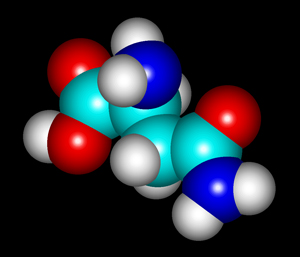
To prepare a sample for study, a very small quantity of the compound was dissolved in several millilitres of room temperature distilled water and a couple of drops of the solution were transferred to a microscope slide. After the water had evaporated, the slide was examined under the microscope to check the quality of the result. Since the crystal structures tend to be fairly large, low power objectives are usually sufficient, and no cover-glass is required. In order to preserve and protect the slide (or to allow the use of a higher power phase contrast objective), a drop of "Permount" (or other non water soluble mountant) may be placed directly on the completely dry crystal structures and a cover-glass carefully added. Note that l-asparagine acts as an eye and respiratory irritant, and contact should therefore be avoided.
In this article, I hope to show how crystalline structures can be resolved by a variety of illumination methods. All images were captured by a Nikon Coolpix 4500 digital camera connected to a Leitz SM-Pol microscope.
This equipment allows the use of several condensers:
(a) Leitz polarizing condenser 702 fi Achro 0.90 P (strain free)
(b) Leitz phase contrast condenser 402a Achro 0.90
(c) Leitz dark-ground condenser - dry D 0.80
A number of objectives were utilized.
(a) Leitz Pl 2.5x / NA 0.08 P (strain free)
(b) Leitz NPl 6.3x / NA 0.20 P (strain free)
(c) Leitz NPl 16x / NA 0.40 P (strain free)
(d) Leitz NPl FLUOTAR 25x / NA 0.55 Phaco 2 phase contrast
A Leitz Periplan GF 10x eyepiece was used in the formation of all images.
In addition, when using polarized light, a number of compensators were sometimes placed in the light path.
(a) l/4 circular compensator that fits into the polarizing condenser and can be partially rotated
(b) l/4 slider compensator that fits into a slot above the objective
(c) l slider compensator that can replace the slider in (b) as required
In all cases where the polarizing condenser was used, the polarizing filter was adjusted to give a completely black background (extinction position). Different compensating plates or combinations of plates produced the differences in appearance.


objective 6.3 x
left: l/4 circular compensator,
right: l/4 circular compensator (different angle)
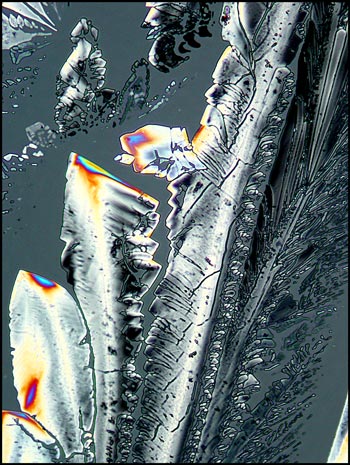
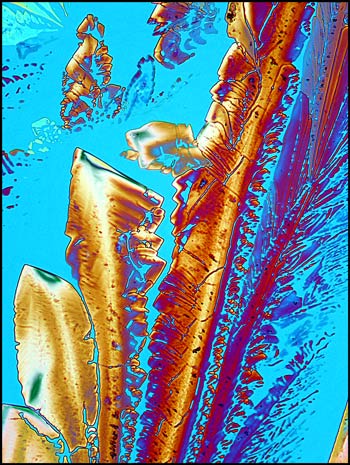
objective 6.3 x
left: l/4 circular compensator,
l/4 slider compensator
right: l/4 circular compensator,
l slider compensator
A completely different perspective can be obtained by using dark-ground illumination.
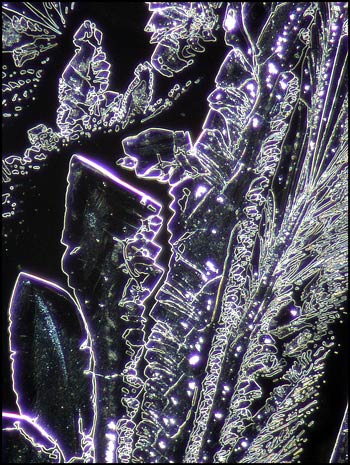
objective 6.3x
dark-ground condenser
Here is a different crystal field, again using the polarizing condenser.


objective 6.3 x
left: no compensators
right: l/4 circular compensator,
l slider compensator
Curious repeating elements often form a pattern in l-asparagine crystal formations. In most cases the elements are based on an incomplete or eroded parallelogram form.


left: objective 6.3 x, l/4 circular compensator
right:
objective 16x,l/4 circular compensator (different angle)
The image below shows the tip of the similar formation at a higher magnification. The three-dimensional appearance results from the use of the phase contrast PHACO 2 objective along with the phase contrast condenser set at 4 (instead of the required 2 value).

objective 25x PHACO 2
phase contrast condenser set at 4
Occasionally, small perfect crystals form in the field. Notice that the irregular forms are absent in the area surrounding the crystal.


left: objective 2.5x,
l/4 circular compensator,
l/4 slider compensator
right:
objective 6.3x, l/4 circular compensator (different angle),
l/4 slider compensator

objective 2.5x
l/4 circular
compensator
The surrounding structures are made much clearer by the use of dark-ground illumination.

objective 6.3x
dark-ground condenser
Several truncated crystals similar to the one below could be seen on the slide.
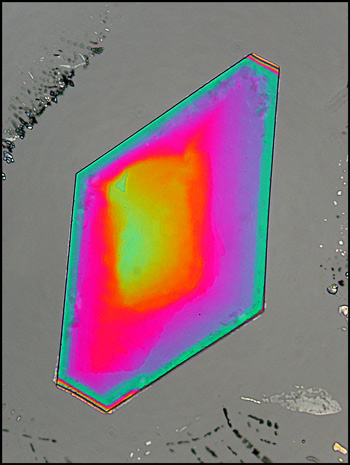
objective 16x
l/4 circular compensator
At the edge of the coverslip, it appears as though the combination of l-asparagine, Permount and air interacted to produce the following strange formations. (This did not happen in every slide preparation.)

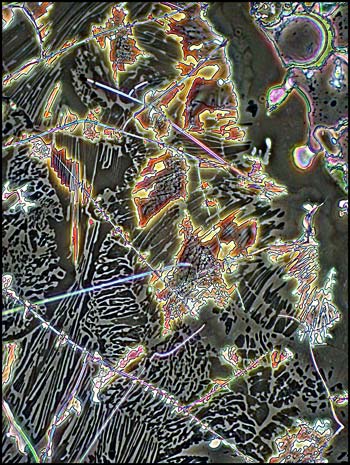
objective 25x PHACO 2
phase contrast condenser set at 2

objective 25x PHACO 2
phase contrast condenser set at 2
Although l-asparagine is certainly not as photogenic as many other compounds, I hope that this brief discussion shows the value of trying different lighting techniques to enhance visualization.
For more information on the topics of compensator use and digital photomicrography, please see my earlier article on Ascorbic acid.
All comments to the author Brian Johnston are welcomed.
Published in the July 2004 edition of
Micscape.
Please report any Web problems
or offer general comments to the
Micscape
Editor.
Micscape is the on-line
monthly magazine of the Microscopy UK web
site at
Microscopy-UK
© Onview.net Ltd, Microscopy-UK, and all contributors 1995 onwards. All rights reserved. Main site is at www.microscopy-uk.org.uk with full mirror at www.microscopy-uk.net.